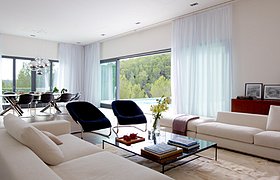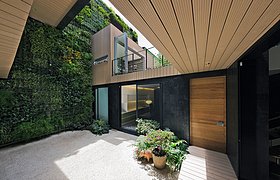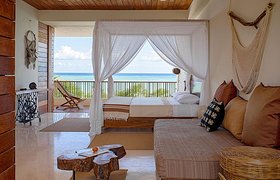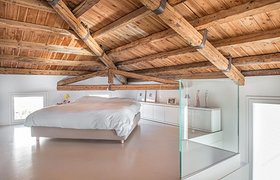Casa Almare is situated on a cliff overlooking Bahía de Banderas on the Pacific Ocean.
The project was born from a unique commission that presented a twofold challenge. The first part of the task consisted in the selection of the plot for the building; the second part instructed that we design a holiday home without an established user in mind. With its open facade, its clean, simple lines and its stark interiors, the house stands as the result of an involved experiment that dealt with unusual topographic and programmatic requirements.
The area surrounding Casa Almare is home to some of the most rugged landscape in all of Bahia de Banderas and so the selection of the plot was a painstaking process. We decided to build right off the face of a cliff facing the water, braving a few structural challenges in favor of establishing a more direct relationship with the ocean and delivering a fuller experience of the sea, beyond simply offering great views.
When the plot had been defined, we began to work with the developer to arrive at a market d program for the house. Because we´d always worked closely with our clients to tailor the project to their needs, having no user-client implied the risk of producing a solution that would lack the necessary personal specificity. We decided to address this concern by providing all rooms of the house with plenty of privacy and autonomy.
And so we began to design with two cardinal concepts in tension: on the one hand, the desire to create enough openness to afford great views and a direct experience of the ocean; on the other, the constant need for privacy between spaces.
Given these two conflicting requirements, as well as the spatial restrictions of the plot, we proceeded to arrange the program on discreet blocks, stacked on top of each other, which resulted in a freestanding concrete structure with four levels. By disengaging the building from the cliff we were able to provide all spaces of the house with enough natural lighting and ventilation.
As a means to enhance environmental comfort we created multiple openings on corridors. These are meant to produce freshening air drafts that are coupled with the stack effect created by the atrium/light well between the building and the cliff. Additional sustainable features include the use of solar panels and solar water heaters.
There are two well defined functional regions throughout the building. The frontal section of the house, which faces the sea, accommodates all sleeping and entertaining spaces. The rear section, which opens to the light-well and faces a limestone retaining wall set against the stone cliff, accommodates all auxiliary and service spaces. The four guest suites are found on levels 2 and 3; the master suite, kitchen, dining, living spaces and pool terrace are all on the ground floor. Every suite is granted ample space and is fitted with its own dressing room, private terrace and Jacuzzi.
Access from the street is on the top floor, through a discreet concrete portal that s a wood and l screened gate. As the house is approached, the spaces between the wood slats give away hints of the incredible views of the ocean beyond. The garage gate opens to an outdoor vestibule that houses the parking and storage areas, engine room and staff dormitory. There is a separate pedestrian entry that opens to a small pond and some greenery, next to a wide pathway that becomes a bridge. This bridge crosses the light well and provides access to a transitional roof terrace that sits atop the building with its own bar and bathrooms. Vertical access between levels is granted through a central stairwell that wraps around an elevator.
The material palette throughout the house is simple. White, plastered walls and marble floors help preserve cool temperatures in all rooms and allow daylight to travel deep into the back of the house. The stone slabs that cover all floors and bathroom walls were carefully cut and assembled so as to minimize odd residual cuts on the edges. The front of the house facing the bay is mostly glazed from floor to ceiling in order to take full advantage of the views of the ocean. These stark, white and beige cool surfaces contrast with the darker tones and grittier textures of the woodwork which uses tropical, hardy Cumaru on all exteriors and Tzalam on interiors.





